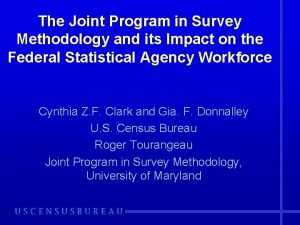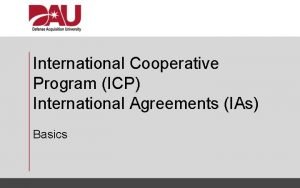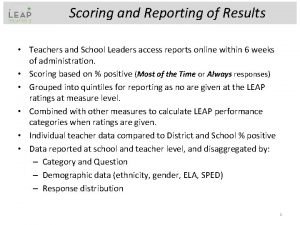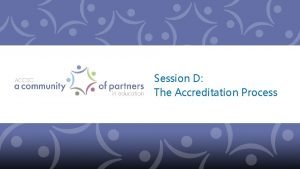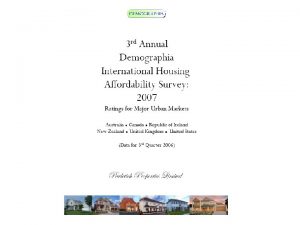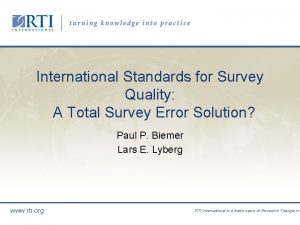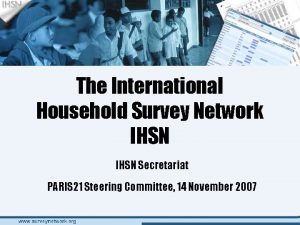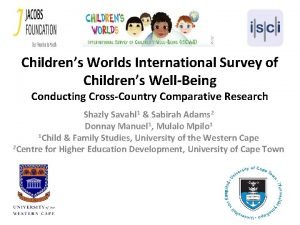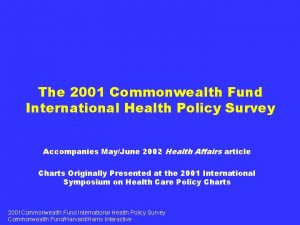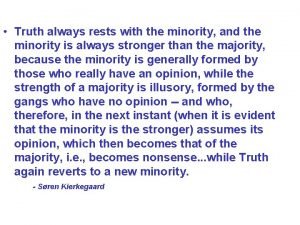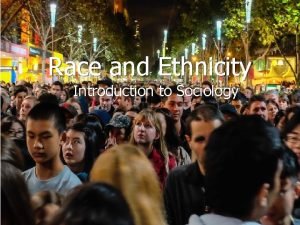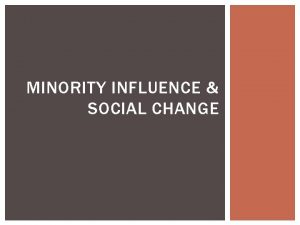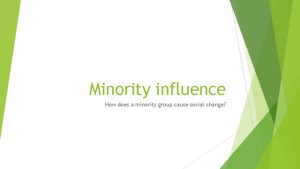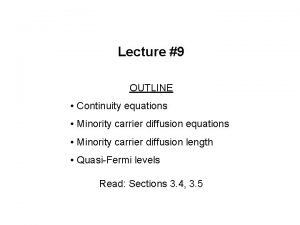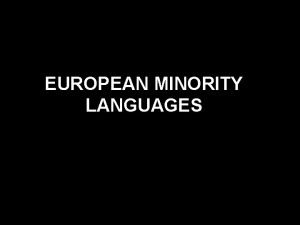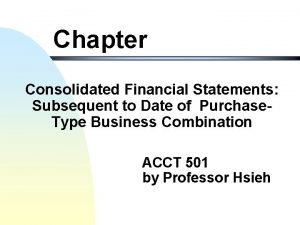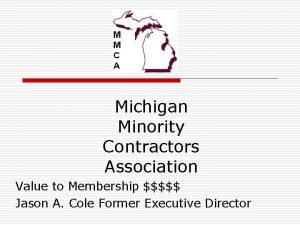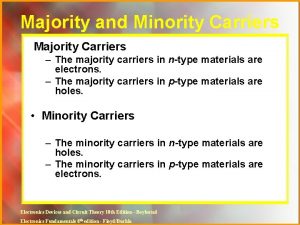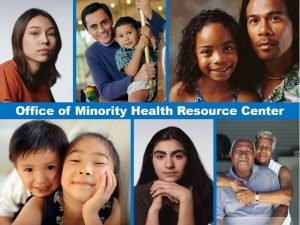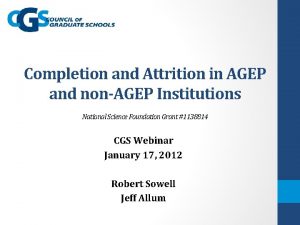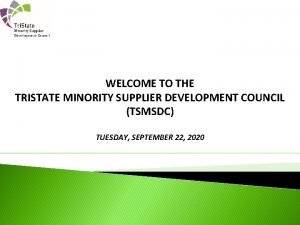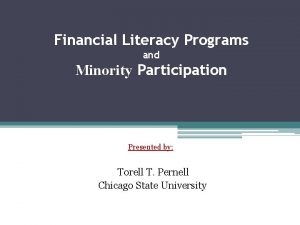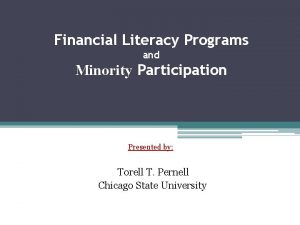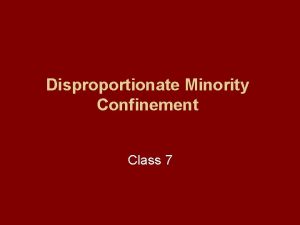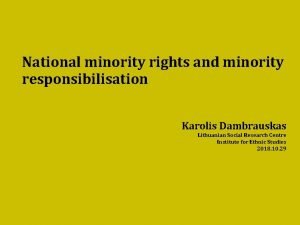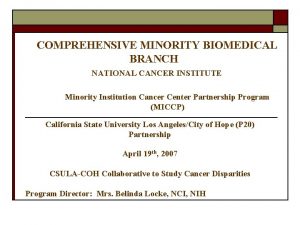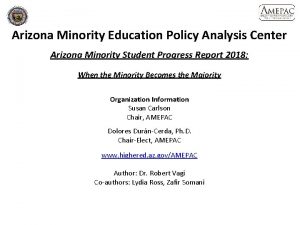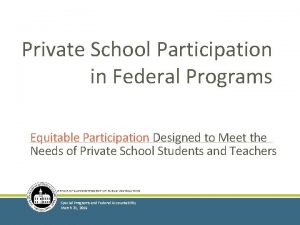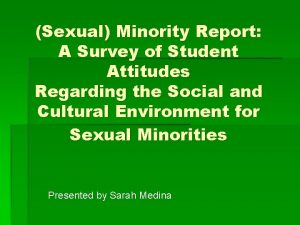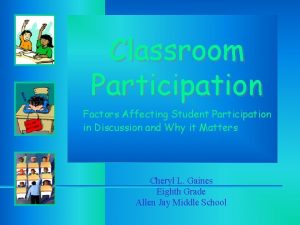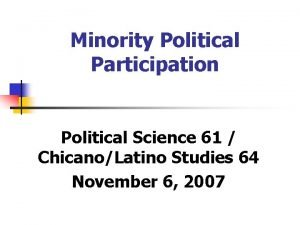Minority Student Participation in International Programs A Survey

































- Slides: 33

Minority Student Participation in International Programs: A Survey of Undergraduate Students Attending HBCUs Komanduri S. Murty & Jimmy D. Mc. Camey, Jr. Fort Valley State University Applied Demography Conference, San Antonio, TX January 8 -11, 2014

Study n This study was first conducted in collaboration with the UNCFSP for its grant from USDOE in 2007. Taking a subset of the data we examine minority HBCU students’ perceived importance and experiences (formal and informal) with international education activities.

Justification n There is a wide gap between the percentage of Blacks or African Americans enrolled in postsecondary education and the percentage that study abroad (28. 3% difference), as well as those who earn degrees in international study areas—Area, Ethnic, Cultural, and Gender Studies (18. 4% difference), and in foreign languages, literatures, and linguistics (27. 5% difference) Percentage of Blacks that participate in study abroad and international areas compared to the overall percentage of Blacks enrolled in postsecondary education

About the data n The data set consists of 1, 346 undergraduates from 62 HBCUs: • 33 (53. 2%) 4 -year public institutions • 28 (45. 2%) 4 -year private institutions • one (1. 6%) 2 -year public institution. n Over half (59. 0%) of the participating students were from eight institutions

About the data, Cont… n Student participants in the study sample were generally representative of the overall enrollments of the sample institutions at the time of survey Comparison of the percentage of students in the sample vs. the overall enrollments at the sample HBCUs

Variables used for comparison n Four variables of interest were identified for this analysis: • Gender • Primary Area Where Raised • First-Generation College Student • Classification


Racial Representation n The overwhelming majority of the sample was Black or African American which is consistent with the general population of HBCUs overall (96% Black) Race No. Percent Black or African American 1251 92. 9 White 62 4. 6 American Indian or Alaskan Native 50 3. 7 Asian 19 1. 4 Native Hawaiian or Pacific Islander 6 . 4 Did Not Report 55 4. 1

Results

Results, Cont… n n n Females over males Students from rural back ground (farm and non-farm) over urban & inner cities First generation students over others Perceived that these skills are very important/somewhat important in the job market. n Response patterns by classification were not consistent

Results, Cont… n Students were asked to indicate their degree of agreement on 10 items related to various international curriculum aspects and benefits (Table 2).

Results (contd. )

Results (contd. )

Results (contd. )

Results (contd. )

Table 2 summary n n Consistent with Table 1, males over females; and, students with rural residential backgrounds over those from urban areas were higher among those strongly agreed/somewhat agreed with most the first two notions Approximately 75% of HBCU students strongly or somewhat agree that all undergraduates should have a study abroad experience, be required to take course covering international topics and be required to study a foreign language if they don’t already know one

Table 2 Summary (contd. ) n n Over 86% of HBCU students strongly agreed or somewhat agreed that all undergraduates should be required to study one foreign language if they do not already know one Females over males; and, nonfreshmen over freshmen tend to agree more frequently with this requirement.

Table 2 Summary (contd. ) n n n Nearly 81% strongly agreed or somewhat agreed that all undergraduates should have a study abroad experience sometime during their college or university career; and, 76% strongly or somewhat agreed that all undergraduates should be required to take courses covering international topics No significant differences were found in these response patterns by gender, classification, residential background, or whether they were first generation college students

Table 2 Summary (contd. ) n n At least 9 out of 10 agree or strongly agree that studying international topics, foreign languages, and visiting other countries will increase their understanding of (a) their own culture and values; as well as, (b) other people and cultures; (c) provide them with skills to work with people from diverse backgrounds; and, (d) help them get a better job. Over all, females’ attitudes towards international education experiences tend to be more positive than males

Nationality & Foreign Language Proficiency n n Nearly 95% of the student respondents were reportedly the U. S. Citizens (n=1, 278) Approximately 88% (n=1, 180) studied a foreign language before college. Only 11% (n=150) were native speakers of a language other than English 60. 5% (n=814) are able to speak or read at least one language besides English; of them, Spanish (67%) and French (21%) are most commonly spoken languages. These trends are consistent with that of the Nation; however, Arabic ranked 3 rd in this study sample, while it ranked 10 th in the nation (see Association of Departments of Foreign Languages at the Modern Language Association, Foreign Language Enrollments in United States Institutions of ) Higher Education, Fall 2010

Nationality & Foreign Language Proficiency (contd. ) n n 18. 9% (n=154) two other languages 3. 7% (n=30) as many as three or more other languages

Results: Formal Experiences

Formal Experiences (contd. )

Table 3 Summary n 149 of the 1, 346 (11. 1%) respondents traveled outside the United States for academic purposes • Predominantly female (67. 1%) • Raised primarily in urban areas (37. 6%) or inner cities (27. 5%) • Not first generation college students (57. 0%) • Senior undergraduates (38. 1%)

Table 3 Summary (contd. ) n n Three out of every four participants reportedly felt that their travel for academic purposes: (a) increased understanding of other cultures, (b) made them more well-rounded, (c) increased understanding of own culture, and (d) provided skills necessary to work with people from diverse backgrounds. Students with rural residential backgrounds (farm and non-farm) compared those from urban and inner city areas tend to feel more strongly about the later two benefits (c and d).

Table 3 Summary (contd. ) n n Students were asked to rate the importance of participation in four different international education experiences All these activity participations received higher ratings of importance from females than males Perceived Importance of Academic Study Activities

Results: Informal Experiences

Informal Experiences (contd. )

Table 4 summary n A total of 521 students (38. 7%) reportedly traveled outside the United States for nonacademic purposes • Canada (18%), Bahamas (13%), & Mexico (12%) were most commonly traveled countries • Predominantly female (68. 3%) • Raised primarily in urban areas (39. 0%) or inner cities (29. 0%) • Not first generation college students (56. 8%) • Senior undergraduates (34. 4%)

Table 4 summary (contd. ) n Students were asked to note the benefits related to their nonacademic travel abroad in six areas identified in the literature Benefits of non-academic travel identified by survey participants

Table 4 summary (contd. ) n Males more often than females reported the following benefits of travel outside the US for nonacademic purposes: • Increase their understanding of their own culture and values • Increase their foreign language skills • Help them get a better job

Reasons for Non-participation in international travel for academic and/or non-academic activities

Recommendations n n n n Sustainability of Students’ Interest Increasing Students’ Motivation, Awareness, and Participation Strengthening Study Abroad Programs Increase Focus on Critical Languages Increase Focus on Male Students Lessons to Learn From More Successful Campuses Conduct Further Research
 Simbol dari weak entity
Simbol dari weak entity Disadvantages of waterfall model in software engineering
Disadvantages of waterfall model in software engineering Joint program in survey methodology
Joint program in survey methodology Abcd acls
Abcd acls Navy international programs office
Navy international programs office Ias coop
Ias coop Student perception survey dps
Student perception survey dps Odu student opinion survey
Odu student opinion survey Australasian survey of student engagement
Australasian survey of student engagement Student survey form
Student survey form Accsc student survey
Accsc student survey Universum student survey
Universum student survey Demographia international housing affordability
Demographia international housing affordability International quanity survey
International quanity survey International crime victim survey
International crime victim survey International household survey network
International household survey network Children's world survey
Children's world survey Commonwealth fund international health policy survey
Commonwealth fund international health policy survey Truth always rests with the minority
Truth always rests with the minority Define minority group
Define minority group 3 behaviours that enable a minority to influence a majority
3 behaviours that enable a minority to influence a majority Define minority group
Define minority group Continuity equation semiconductor
Continuity equation semiconductor Difference between npn and pnp transistor
Difference between npn and pnp transistor What is a minority
What is a minority Reasons why control accounts are prepared
Reasons why control accounts are prepared Minority interest example
Minority interest example Define delimit demarcate administrate
Define delimit demarcate administrate Minority contractors near me
Minority contractors near me Difference between majority and minority carriers
Difference between majority and minority carriers Indigenized dialect examples
Indigenized dialect examples Office of minority health resource center
Office of minority health resource center Doctoral initiative on minority attrition and completion
Doctoral initiative on minority attrition and completion Tsmsdc
Tsmsdc


